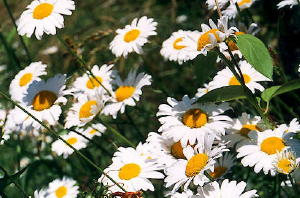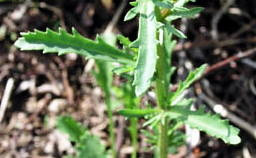Prince Edward County, Ontario, Canada
Time for Ox-eye Daisy Snacks
OX-EYE DAISY SNACKS
My late father never worried too much about weeds on the farm. Crop rotation generally kept most weeds in check, and a sharpened hoe did an adequate job in keeping them out of our potato patch and tomato fields. I know, because I was usually at the other end of that hoe.

But he was relentless when it came to Ox-eye Daisy. Although long admired by song writers and poets, he saw it as an invasive weed that would take over pasture fields and hay fields. When a neighbouring farm came up for sale, he quickly bought it as he saw the new land purchase as an effective buffer zone if we could but get the existing patches of Ox-Eye Daisy there under control. A road that ran the full length of our farm on its east side was a suitable barrier, and the Bay of Quinte ensured that none would appear along the frontage. In his eyes, we had just set up an effective line of defence. Every year, in June, he’d scan the hay fields for any blooms, then off I’d go with a burlap bag and a pointed shovel to spade up the newcomers.
It was many years later that I would find a new use for ox-eye daisy. The leaves are delicious, and resembling fresh radishes in taste, is often an ingredient in our salads now. Even on a causal walk, I enjoy plucking a few leaves as I go, just for a snack to keep me going. But its use as an edible item is not new; historically, the plant has been used for years to cure whooping cough, asthma and other coughs. Pioneers often made a tea from its leaves to be used as an antispasmodic. The plant is even mentioned in Peterson’s “Edible Wild Plants.” Ox-eye daisy is mildly aromatic, much like it close cousin, chamomile. Teas made from this plant are claimed to be useful for relaxing the bronchials, and has been used as an antispasmodic for colic and general digestive upset.
However, my father had good reason to worry. Ox-eye Daisy is recognized as an invasive plant, capable of sending out over 26,000 seeds per blossom each year. Like many of our plants, commonly recognized as weeds, Ox-eye Daisy was introduced from Europe in the 1800s, as an ornamental. It very quickly escaped cultivation. To add to the problem, Ox-eye Daisy seed has even been found in some wildflower seed mixes. The plant is a member of the Asteraceae family, the same family as the sunflower. The flower heads are borne individually at the tops of long, slender stems. But convincing property owners of the danger of Ox-eye Daisy is never an easy task due to its showy flowers, and its similarity to Shasta Daisy, a popular choice for flower beds.

In the meantime, if the Ox-eye Daisy is not a concern on your property, enjoy the benefits of its presence as I do, by browsing on its delicious leaves, or adding it to your salads this month. They just started to come into bloom early this month, and should persist right into next month.
Check out this recipe for Daisy Wine:
1 gallon freshly picked daisies
1 pint golden raisins, finely chopped
2 peeled lemons, thinly sliced
1 peeled orange, thinly sliced
2 lbs 3 ozs finely granulated sugar
7 ½ pts water
1/4 tsp tannin
1 tsp yeast nutrient
hock or champagne wine yeast
Pick the flower heads only, without stems, after morning dew has evaporated. Wash and place in primary. Pour water, hot or cold, over flowers and cover primary. Let stand for two days, then strain off and retain liquid, squeezing the blossoms to get maximum flavour. Discard flowers and add remaining ingredients, stirring well to dissolve sugar completely. Recover and set aside for two weeks, stirring daily. Strain liquid in secondary, discarding citrus and raisins. Fit airlock and set aside until fermentation ceases and wine clears. Rack, top up and refit airlock. After one month, rack again. After additional month, rack into bottles and enjoy immediately. This wine will keep well, but will not retain its bouquet more than a year.